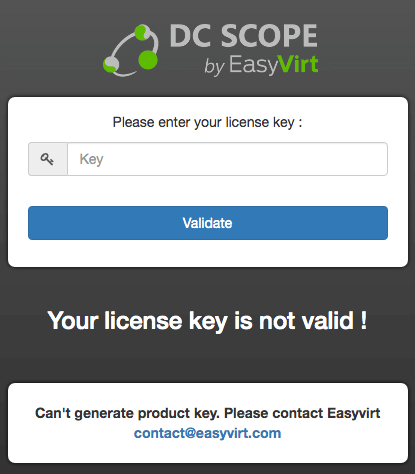Menus
The General Menu of DC Scope is available at the top of the screen. This menu is accessible from the different modules of the solution.
Search bar
The menu is composed by a search bar of all the elements in the infrastructures and the general settings of DC Scope.

The Search Bar of DC Scope allows to search all the elements in the infrastructure or in the filter, if this last is selected. The scope of the search includes: Clusters, Servers, VMs and Datastores.
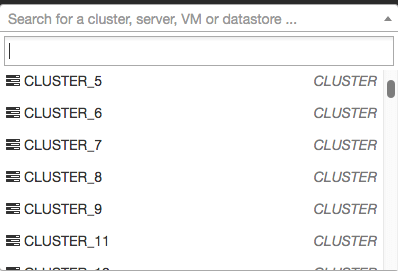
Settings
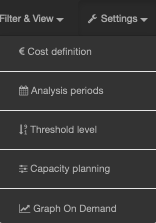
Cost definition
The Cost definition section allows to enter the costs associated to the physical server and to define a fix cost for the VM's and the datastore. Only the Root user can set these costs.
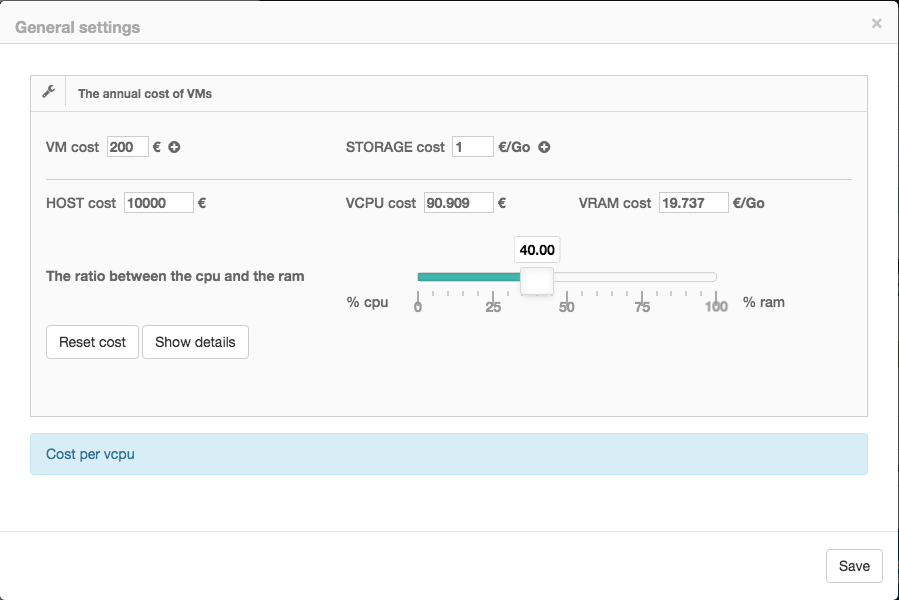
DC Scope includes a default list of cost that can be customizable to the preference of our clients. By clicking the + button next to the VM Cost rate or the Storage Cost rate, DC Scope will provide a detail view of individual items according to the selected category.
If the VM Cost rate or the Storage Cost rate show the legend n/a, it means that individual costs have been given to the resources (VMs or Data stores).
VM Cost
The VM cost corresponds to the fixed cost of one virtual machine. DC Scope includes a default list of cost that can be adjustable and corresponds to the cost of maintenance, license, etc.
Each virtual machine can be assigned with an individual fixed cost by clicking on its value in the cost column.
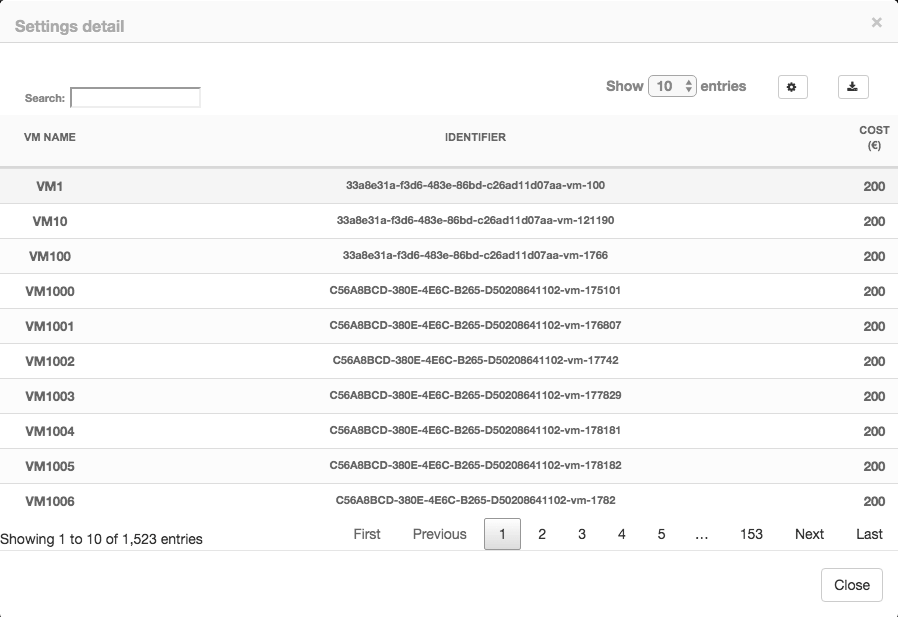
Storage cost
The Storage Cost is the cost per Gigabyte in the datastore. This is a generic and modifiable cost. Each datastore can be assigned with an individual fixed cost by clicking on its value on the cost column.
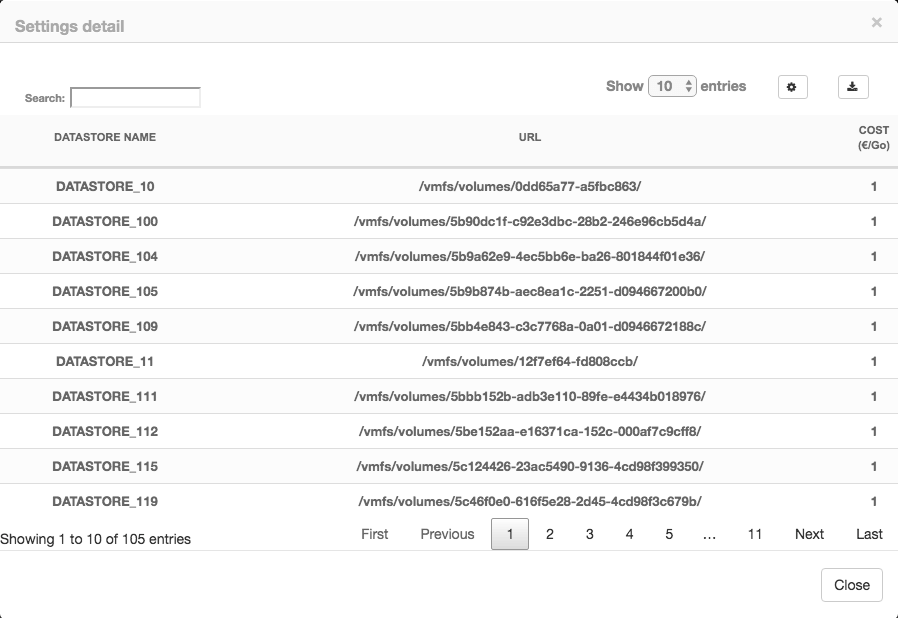
Host cost
The Host Cost is the cost of the physical server (ESX). This cost takes into account the cost of purchasing, maintenance, electrical consume, etc. The ratio in the distribution of costs between VCPU and VRAM assigned to the virtual machines is by default 40% for the VCPU and 60% for the VRAM.
By changing the ratio, the cost of VCPU and VRAM will automatically change. In the same way if the VCPU or VRAM cost is changed, then the ratio is automatically modified to guarantee the accuracy in the cost of the physical server. Clicking in the Show Details button will provide the detail of cost of each physical server (ESX) in the infrastructure.
DC Scope provides default costs that can be modified by clicking on the cost value of each server. If individual costs are assigned to physical server the value of the ratio is no longer modifiable.
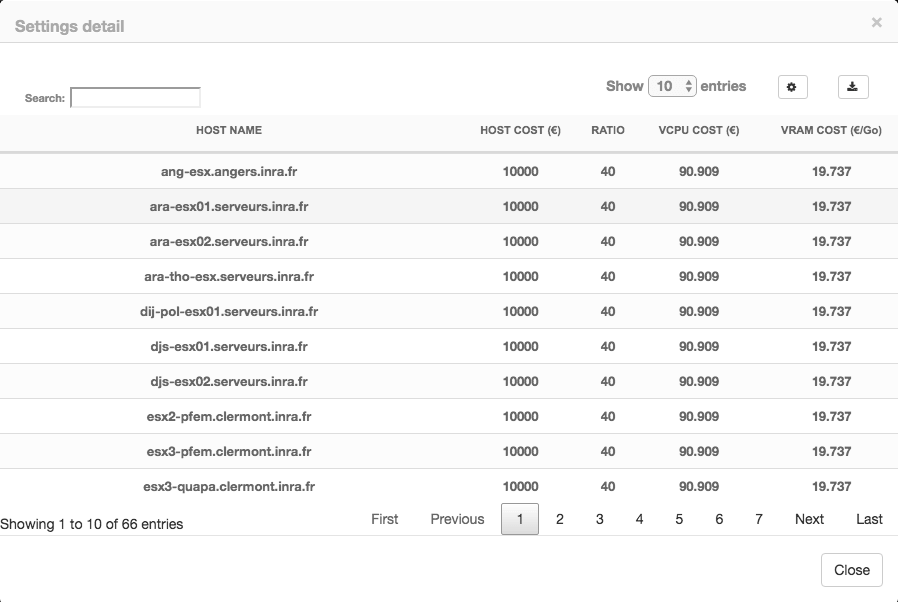
The Reset button resets the physical server costs, VCPU and VRAM to its default values. In this case, the previously defined costs of the physical servers will also be reseated.
Analysis periods
In this section you can define the working hours and days for your organization. Once defined, you will be able to create filters that only incluide the working hours and days for your organization.
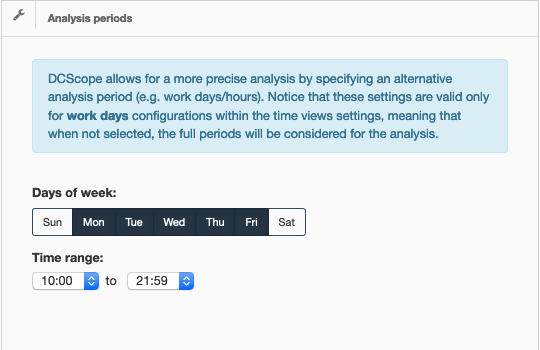
Please bear in mind that a modification of the working hours will regenerate the databases for the working hours and days. The filters already created in the infrastructure will provide the information from the day the modification was done.
Threshold level
A VM can generate unreal activity for many reasons. Unused VMs, will almost always generate certain level of activity (antivirus, VMware tools, backups, etc.). Therefore, it is very difficult to identify the VMs that are not being used. To solve this issue, DC Scope uses the notion of noise in the VM. This notion of noise is an analysis of the VM that compares the use of the VM over the time (100%, 99.99%, 99.9% and 99% of time) at certain thresholds of activity (2%, 5% or 10% of activity). The result allows us to precisely determine the activity of the VM. It is important to take into account this particular activity to acquire a robust analysis.
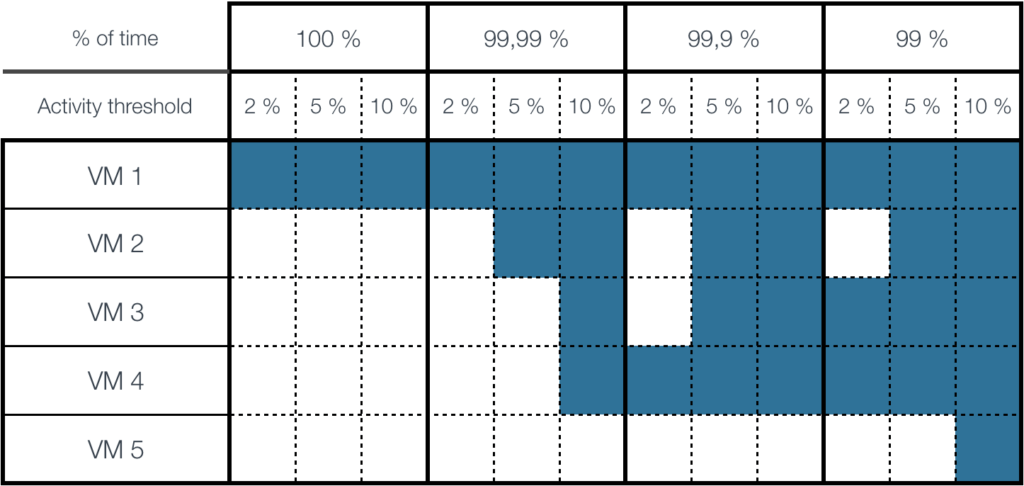
Capacity Planning
The Capacity Planning settings allows to customize the over commitment rates of resources in the infrastructure. By default, DC Scope applies the over commitment rates recommended by VMware of: 4 VCPU for logical core and 166% of RAM Memory.
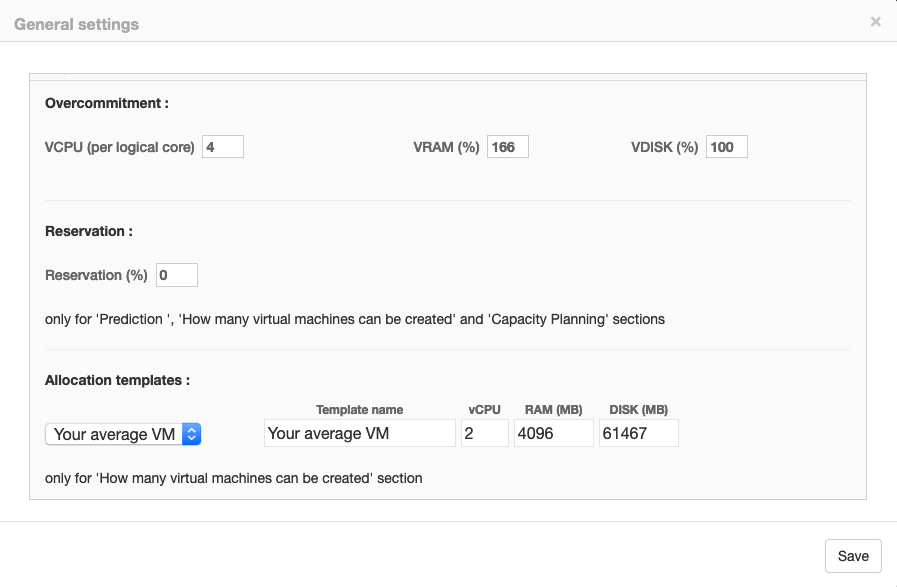
Reservation
The Reservation field, is a customisable percentage rate of the infrastructure (or filter) that will be excluded from the analysis of DC Scope.
The reservation rate can be set-up according to the Business Continuity Plan and its purpose is to leave a percentage of resouces available in case of incidents in the datacenter.
The Reservation rate will affect the frame "Evolution of Resources" in the dashboard and the the Capacity Planning module.
Allocation Templates
With the allocation templates you can create three VM templates (eg. small, medium, and large), and which will be used for the ratio used in the frame "How many VMs can you still create" in the dashboard and on the Servers Overview > Synthesis section.
Graph on demand
In this section you can define the default counters to appear for each resource in the Graph on Demand module of DC Scope.
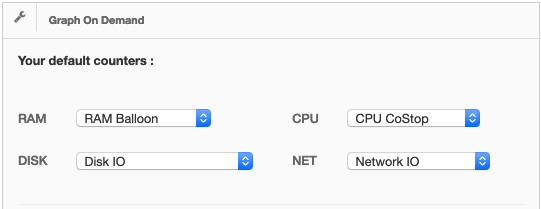
DC Scope status
The DC Scope Status menu of DC Scope provides general information of the status of DC Scope such as license, connection to VCenter, log and the possibility to install updates directly from the solution.
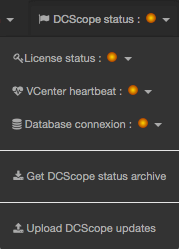
The DC Scope Status drop-down menu provides the following information:
License status:
It shows the expiration date of the license and the number of VMs associated to the license DC Scope.
VCenter Heartbeat:
It indicates the connection status to the VCenter. If the indicator dot is in orange or red it indicates that there is a problem in the connection to the VCenter in the infrastructure. Please verify the connection of DC Scope to the VCenter and if needed, contact Easyvirt in order to solve the issue.
Database Connection:
It indicates the status of the Database of DC Scope.
Get DC Scope Status Report:
It will download the event log of DC Scope since its deployment in the infrastructure.
Upload DC Scope Updates:
This button allows you to install DC Scope updates.
User Menu
The DC Scope user menu provides general information of the user and allows to make changes in the general administration of DC Scope.
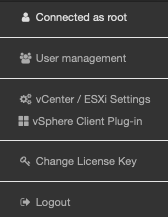
Create User
By clicking on the Create User button, a frame with a wizard will appear. In the first frame you need to add the account information of the new user (name, password, email and currency). The second frame allows to delimit the elements that will be available for the new user.
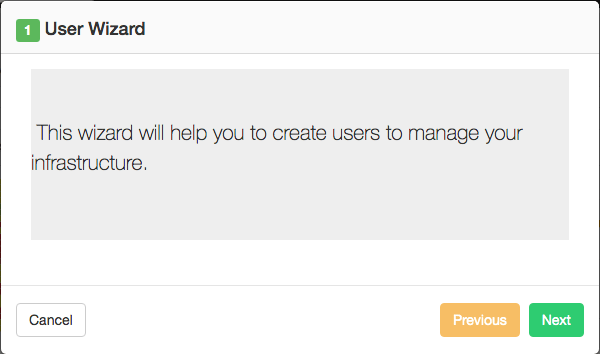
User management
All LDAP user who connects to DC Scope must be created through this wizard. Only the Root Account can add or delete users. The User Management tool allows you to modify the characteristics of a user. This menu is only available through the Root Account. In this section, administrators can:
- Delete accounts.
- Change user names.
- Change the currency for users.
- Change password for users.
- Modify the email address.
- Modify the elements available for user

User settings
As mentioned before, the User Management option is only accessible from the Root Account. However, non-root users can modify some configurations of its own accounts such as:
- User name.
- Email address.
Management of local user accounts
It is possible to display the list of users as well as the creation of a user Via LDAP & SNMP.
LDAP and SNMP configurations are performed from the DC Scope VM Administration Console, accessible from the VMware Console.
LDAP configuration:
- Enter the address of the LDAP server and enter the desired group.
- Recover the SSL certificate, necessary to connect to LDAP.
SNMP configuration:
- Manually edit the SNMP configuration file.
- Create an SNMP v3 user that can then be used to monitor the VM DC Scope.
- Restart the SNMP service to take into account the changes made.
VCenter / ESX Settings:
Adding or removing VCenter/ESX: Within this menu, Root Users can add or remove vCenter or ESX from DC Scope.
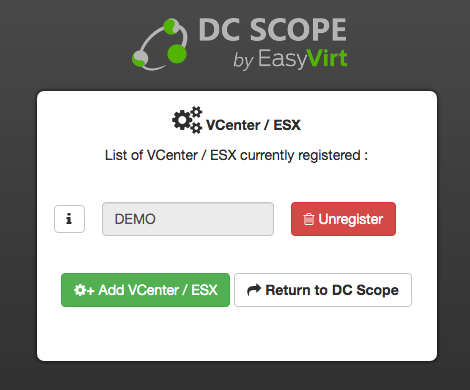
Plugin vCenter :
DC Scope has a plugin that aloows you to show its analisis of VMs and Servers directly from the vCenter (compatible from the version 6.5 U2).
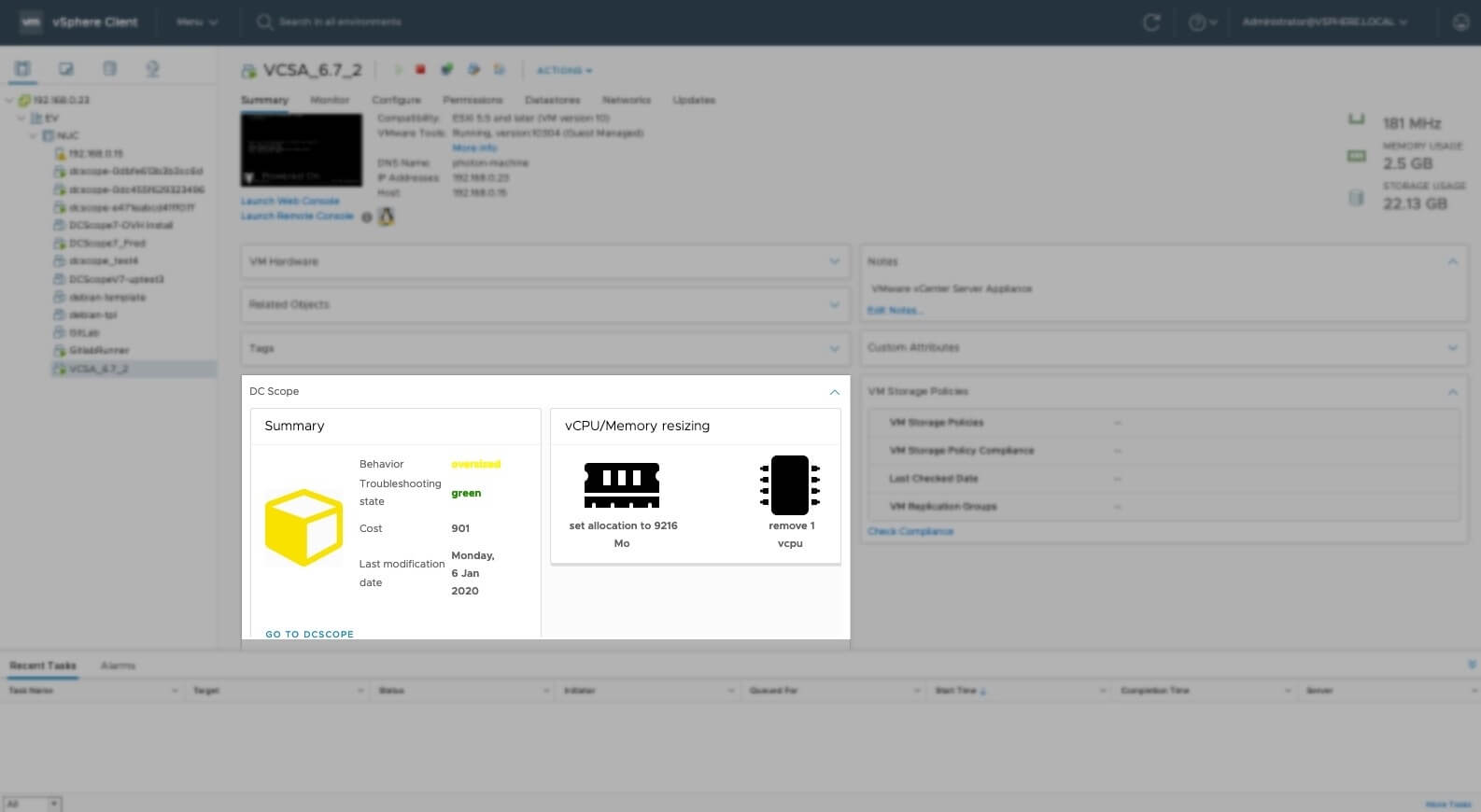
The information available is as follows:
-
From the ESXi overview:
* Total number of virtual machines, on, off. * Saturation dates for CPU and RAM. * Graph evolution of the number of VMs. * Graph capacity/allocation vCPU. * GGraph capacity/allocation vRAM. -
From the VM overview:
2.1 Synthesis of the VM:
* Status (idle, busy, etc...). * Troubleshooting status. * Cost of the VM. * Last modification date.2.2 Resizing optimizations:
* vCPU resizing. * vRAM resizing.
vSphere Client Plug-in Registration
Notes :
* Compatibility : vCenter 6.5 U2 or upper
* After registration, you need logout/login vSphere client and refresh your browser.
** Register plugin hosted on DC Scope :**
1. Download XML.
2. Connect to the vCenter Managed Object Browser: https://<vcenter_address>/mob
3. Browse to 'ServiceContent' then 'ExtensionManager'.
4. Choose 'RegisterExtension'.
5. Paste the content of xml file.
6. Invoke method (the return result must be 'void').
** Register plugin hosted on your web server :**
1. Download XML.
2. Download plugin.
3. Copy the plugin zip file to your web server.
4. Edit registration.xml and modify plugin location (<url>).
5. Connect to the vCenter Managed Object Browser: https://<vcenter_address>/mob
6. Browse to 'ServiceContent' then 'ExtensionManager'.
7. Choose 'RegisterExtension'.
8. Paste the content of xml file.
9. Invoke method (the return result must be 'void').
** Register & deploy plugin manually (without web server) :**
1. Download XML.
2. Download plugin.
3. Edit registration.xml and modify plugin location (replace by a dummy <url>, it cannot empty).
4. Connect to VCSA shell : ssh root@<vcenter_address>
5. Unzip the plugin directly in the local cache /etc/vmware/vsphere-client/vc-packages/vsphere-client-serenity/<plugin_folder>: The plugin folder name must be [extension-key]-[extension-version], for instance com.easyvirt.dcscope.vcenterplugin-1.0.0
6. Connect to the vCenter Managed Object Browser : https://<vcenter_address>/mob
7. Browse to 'ServiceContent' then 'ExtensionManager'.
8. Choose 'RegisterExtension'.
9. Paste the content of xml file.
10. Invoke method (the return result must be 'void').
Change License Key
Within this menu, Root Users can re-enter the license key of DC Scope. This in order to add more VMs to the license, extend their current license, renewal of license or adding the Cloud Pricing module.
